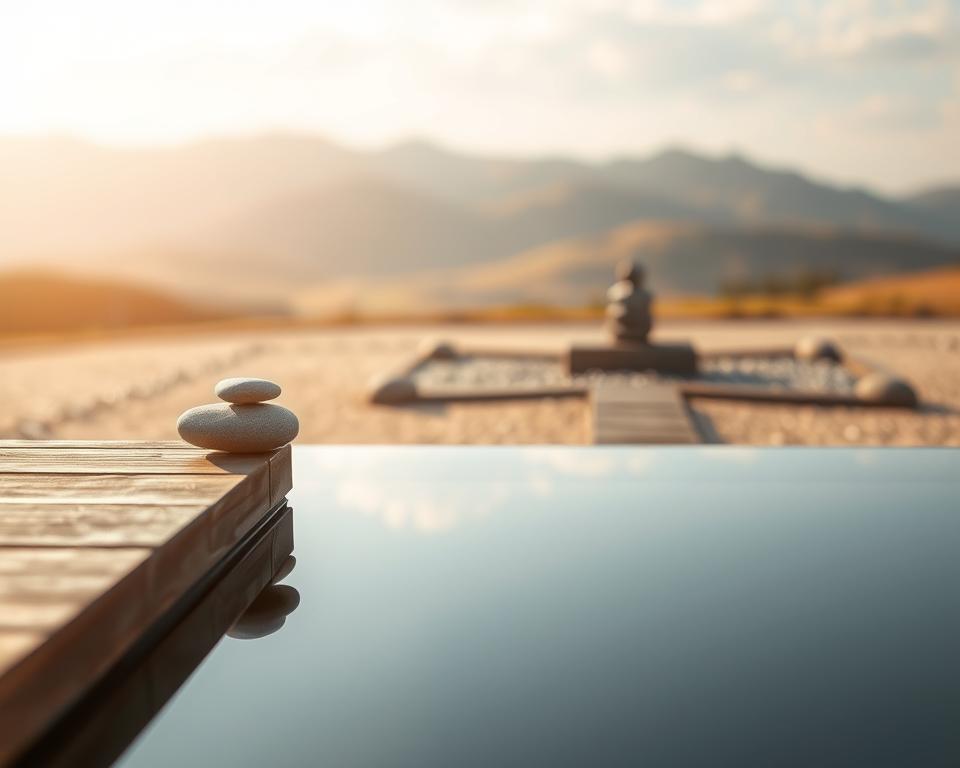Anúncios
Ever wondered if your phone is helping you or pulling you away from what matters? That question opens a practical guide to noticing your habits and making small shifts that stick.
You’ll get clear steps, not rigid rules. This guide uses current research to explain why checking media can become automatic and shows simple ways to notice where your time goes.
We’ll focus on habits you can try at home, in shared spaces, and on the go. You’ll learn how notifications and routines can be adjusted so your phone is a tool, not a constant pull.
Expect a friendly roadmap that covers attention, sleep, privacy, and staying connected to people without losing your energy. Use these tips to build a wellness practice you can revisit over time.
Introduction: Why digital life balance matters right now
Social media now touches how people learn, work, and connect across the country. You likely use a phone for school, errands, and family checks. Many U.S. students report heavy device use and some people check phones up to 150 times a day.
Anúncios
Today’s reality in the United States
Research links social media use with complex mood effects. Some studies show ties to anxiety and depression, especially with early-morning comparison habits. A 2023 U.S. Surgeon General advisory raised concerns about youth mental health and platform time.
What balance looks like in practice
Balance means choosing when to engage and when to rest. It looks like quiet mornings without a screen and muted notifications during focused work. Small steps protect your mind and keep family time meaningful.
How to use this guide
This guide is practical. Try one change at a time. Test an idea for a week and notice how your day shifts.
“Be off screens about an hour before bed to help sleep and restore rest.”
- Mute non-urgent alerts to reduce noise.
- Batch messages to save time.
- Use prompts to check your stories about scrolling.
We ground tips in current research while noting limits; your experiences may vary, and that’s okay.
Foundations of digital life balance
Think of your devices as tools: first decide the tasks you want them to handle, then set simple rules that support your goals.
Guides, guardrails, and your goals
Start by writing one short sentence about how technology should serve your day. For example: “I want more calm mornings and fewer interruptions during work.” This helps you pick apps and settings on purpose.
- Set practice guardrails: quiet blocks, message windows, or a single check-in hour.
- Use basic tools like timers, focus modes, and app limits to protect your time.
- Decide where your phone lives for meals and sleep to reduce impulse checks.
Signals that your tech use needs a reset
Pay attention to your body and mind. Racing thoughts, irritation after scrolling, or trouble switching tasks are red flags.
Look for patterns such as late-night phone use, skipped meals, or shorter attention while reading. These clues point to stress and drained energy, not moral failure.
“Small guardrails can give your mind space to rest and help you notice what actually matters.”
Try micro check-ins each evening: note which media helped and which drained you. Adjust rules weekly so your boundaries serve you, not the other way around.
Audit your attention: apps, notifications, and settings
Give yourself seven days to map when and why you check your phone. A short audit shows which apps and hours cause the most interruptions.
Start with a one-week screen and notification audit
Each day, log time by app and note the activities you were doing when a ping came. People check phones about 96–150 times a day and may get 140+ notifications.
Trim, mute, or batch: practical notification tactics
Turn off badges and sounds for non-urgent apps. Keep only people-first channels active in real time.
- Use scheduled summaries two to three times per day.
- Cap high-draw apps with daily limits that match your goals.
- Create friction: sign out or remove widgets that invite quick opens.
Reorganize your home screen to reduce impulse checks
Sort apps by purpose: work, navigation, banking versus pull-driven media. Move pull apps off the main screen.
Set device-level limits and focus modes that fit your day
Use focus modes for deep work, driving, or home. Customize which contacts and apps can break through. Protect bedtime by silencing alerts and putting the phone out of reach for the hour before bed.
Review your notes at week’s end and adjust settings, hours, and layouts based on what disrupted your day most.
Want a deeper approach? Try this digital minimalism guide for more tools and examples.
Social media and your mood: use with care, not fear
How you use social media matters more than how much you see at once. Research suggests risk for mental health concerns rises when people spend over about three hours a day on platforms. That doesn’t mean shame — it means testable limits.
Time thresholds and what current studies suggest
Treat time as a signal, not a verdict. Studies point to higher odds of anxiety, depression, or body-focused stress after long daily use. Try shorter windows and track how your mood shifts across the day.
Reduce comparison loops and curate your feeds
Early-morning checks often spark comparison. Replace them with a neutral ritual—stretch, message a friend, or read a short article.
- Unfollow accounts that fuel stress or body dissatisfaction.
- Add creators who teach skills, share honest stories, or lift your mood.
- Use mute, hide, or keyword filters when topics trigger anxiety.
Posting with intention: questions to ask yourself
Before you post, pause and ask: What is my intention? Am I sharing a story, wanting connection, or seeking approval?
“Choose actions that fit your values — post to connect, not to fill an empty moment.”
Use app timers and “take a break” prompts to cap sessions. Keep age guidelines in mind for younger people and talk openly about privacy and who sees posts. If low mood or stress persists, pause certain apps and reach out to friends or a professional for support.
Sleep better: create a screen-free wind-down and bedroom
An hour of quiet time before lights-out can give your brain space to settle. Try this as a flexible habit you test for a week; there are no guarantees, but many people notice calmer evenings.

The hour-before-bed rule and why it helps
The hour-before-bed guideline asks you to step away from screens and media. Reducing exposure to bright screens helps your body prepare for rest and may ease the shift to sleep.
Night routines that calm the mind and body
Pick a short routine that fits your home and schedule. Keep it simple so you can repeat it most nights.
- Try the hour-before-bed guideline: read a paper book, do gentle stretches, or breathe slowly for 20–30 minutes.
- Charge devices outside the bedroom or use a dedicated alarm to reduce browsing in bed.
- If your phone must stay nearby, enable Do Not Disturb and allow only key contacts to break through.
- Diminish bright overhead light and skip caffeine late in the day to support your natural rhythm.
- Create a brief habit: tidy one small area, jot worries on paper, and note one good thing from the day.
“Even partial screen-free time can help your mind settle and protect your rest.”
Track the time you spend winding down and how you feel the next morning. Adjust the hour to match family schedules or night shifts. Be flexible — small changes add up and can help protect sleep without strict rules about technology.
Protect your privacy and safety in a connected world
Simple account habits reduce risk and give you more control over access to your personal details. Doxing means someone publishes private data—names, addresses, or photos—to harass. Swatting is a false emergency call meant to summon armed responders. Both are serious and can cause real harm.
Doxing and swatting: what they are and how to lower risk
Limit what you share publicly. Turn off geotags, avoid posting your phone number, and vary usernames and emails between public and private accounts.
Practical privacy steps for social, apps, and accounts
- Review platform settings and set profiles to private where possible.
- Use strong, unique passwords and multi-factor authentication as standard tools.
- Search your name and request removals for sensitive results; remove location data from media.
When to seek help and document incidents
Save URLs, screenshots, timestamps, and messages. If threats escalate or you feel unsafe, contact local police and campus or community support.
“Protect your stress by setting clear boundaries on who can reach you and when.”
Focus, work, and school: reclaim time in your day
Carve short, predictable pockets in your schedule so work and study get your best attention. Simple micro-boundaries reduce friction and help you finish tasks faster.
Micro-boundaries for the office, home, and campus
Set clear blocks: try 25–50 minute focus intervals, then take a 5–10 minute break. These windows protect deep work and give your brain a reset.
- In shared spaces, agree on norms for calls, headphones, and quiet zones so everyone can focus.
- Batch email and chat checks at fixed times; turn off push alerts so you pull messages when ready.
- Use focus modes and simple tools to allow only essential contacts during project sprints.
- Keep a small capture pad for quick ideas so you don’t reach for your phone mid-task.
Align activities with energy peaks: tackle the hardest work when you feel sharp and save light media for lower-energy times.
“Short rituals — a two-minute breath or a quick stretch — cue your brain to start and finish work.”
Review weekly: note which boundaries kept your attention and tweak them as you go. Make the practice fit your schedule, role, and day.
Relationships, play, and real-life connection
Choose one small swap today that turns a scroll into a shared moment with someone you care about.
People often feel more energized after offline social activities, like meeting friends for a walk or playing a quick game. These swaps reduce comparison and help you get comfortable with in-person contact.
Try one simple change this week:
- Trade a 20-minute scroll for a short walk or a pickup game with friends.
- Plan real life meetups and set the phone aside so you can be present.
- Host a hobby night—music, art, or gardening—to engage your hands and body.
Use group chats to arrange shared experiences, not endless feeds. Keep a few simple games—cards, a puzzle, a ball—ready at home for quick, playful turns instead of reaching for your phone.
“Notice how your sense of connection grows when you give people your full attention.”
Protect weekly time for relationships the way you protect a meeting. If distance is a barrier, schedule a short call with a friend and share one highlight and one challenge from your day. Over time, track which activities leave you feeling more alive and keep those on your calendar.
Want more on how technology shapes relationships? Read about the broader impact here.
Career and reputation: your online presence matters
Your online profile often speaks before you do in a hiring context. Recruiters commonly use public profiles to form first impressions: one study found 94% use or plan to use social media for recruiting, and 69% of employers search applicants online.
Build a professional digital footprint on your terms
Start with a quick audit. Search your name and review what appears on page one. Note posts, photos, or news that a hiring manager might see.
- Use simple privacy checks and profile previews as tools to control what people find.
- Share clear work samples and project highlights so your skills match your goals.
- Keep contact info professional and separate from personal phone content when possible.
- Align handles and headlines across platforms so your presence is easy to find and consistent.
- Consider your age and stage: students can highlight coursework; experienced applicants showcase outcomes.
Employers look for evidence that supports qualifications and a professional persona. Avoid posting confidential office details or content that could harm colleagues or clients.
“Treat your public posts like part of your resume—helpful, honest, and free of anything that could raise red flags.”
Revisit profiles quarterly. Use searches, remove outdated items, and engage positively: credit collaborators, comment on industry news, and steer clear of polarizing content. These small steps strengthen your reputation without promising hiring outcomes.
Conclusion
, A short experiment—one boundary or a night without screens—can reveal what helps you most and sets a clear way forward.
Try one or two simple steps this week: mute an app, move your phone from your bedroom, or test a brief wind-down before sleep. These small moves protect time and build better boundaries at home or in the office.
Keep relationships and real life moments central: notice how your mind, rest, and energy respond. Reduce screen noise with gentle guardrails and adjust them as your world and workload change.
Use research as a guide, not a rule. If stress or mental health concerns persist, reach out to a qualified professional. Celebrate small wins and check in monthly to keep your sense of wellness on track.



